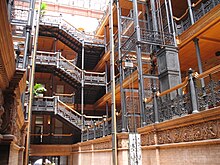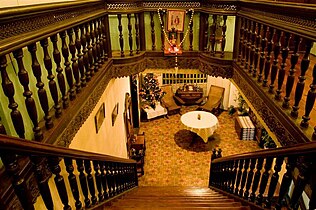Baluster


Abaluster(/ˈbæləstər/) is an upright support, often a vertical moulded shaft, square, orlathe-turned form found instairways,parapets,and other architectural features. Infurnitureconstruction it is known as aspindle.Common materials used in its construction are wood, stone, and less frequently metal and ceramic. A group of balusters supporting ahandrail,coping,or ornamental detail is known as abalustrade.[1][2]
The termbaluster shaftis used to describe forms such as a candlestick, upright furniture support, and the stem of a brass chandelier.[citation needed]
The termbanister(also bannister) refers to a baluster or to the system of balusters andhandrailof a stairway.[3]It may be used to include its supporting structures, such as a supportingnewelpost.[4]
Etymology
[edit]According to theOxford English Dictionary,"baluster" is derived through theFrench:balustre,fromItalian:balaustro,frombalaustra,"pomegranate flower" [from a resemblance to the swelling form of the half-open flower (illustration, below right)],[5][6]fromLatinbalaustrium,fromGreekβαλαύστριον (balaustrion).
History
[edit]The earliest examples of balusters are those shown in thebas-reliefsrepresenting theAssyrianpalaces, where they were employed as functional window balustrades and apparently hadIoniccapitals.[1]As an architectural element alone the balustrade did not seem to have been known to either theGreeksor theRomans,[1][7]but baluster forms are familiar in the legs of chairs and tables represented in Roman bas-reliefs,[8]where the original legs or the models for cast bronze ones were shaped on the lathe, or in Antique marble candelabra, formed as a series of stacked bulbous and disc-shaped elements, both kinds of sources familiar toQuattrocentodesigners.
The application to architecture was a feature of the earlyRenaissance architecture:late fifteenth-century examples are found in the balconies of palaces atVeniceandVerona.These quattrocento balustrades are likely to be following yet-unidentifiedGothic precedents.They form balustrades ofcolonettes[9]as an alternative to miniature arcading.

Rudolf Wittkowerwithheld judgement as to the inventor of the baluster[10]and creditedGiuliano da Sangallowith using it consistently as early as the balustrade on theterraceand stairs at theMedicivilla atPoggio a Caiano(c1480),[11]and used balustrades in his reconstructions of antique structures. Sangallo passed the motif toBramante(hisTempietto,1502) andMichelangelo,through whom balustrades gained wide currency in the 16th century.
Wittkower distinguished two types, one symmetrical in profile that inverted one bulbous vase-shape over another, separating them with a cushionliketorusor a concave ring, and the other a simple vase shape, whose employment by Michelangelo at theCampidogliosteps (c1546), noted by Wittkower, was preceded by very early vasiform balusters in a balustrade round the drum ofSanta Maria delle Grazie(c1482), and railings in the cathedrals ofAquileia(c1495) andParma,in the cortile of San Damaso, Vatican, andAntonio da Sangallo's crowning balustrade on theSanta Casaat Loreto installed in 1535, and liberally in his model for theBasilica of Saint Peter.[12]Because of its lowcenter of gravity,this "vase-baluster" may be given the modern term "dropped baluster".[13]
Materials used
[edit]
Balusters may be made ofcarved stone,cast stone,plaster,polymer,polyurethane/polystyrene,polyvinyl chloride(PVC),precast concrete,wood,orwrought iron.Cast-stone balusters were a development of the 18th century in Great Britain (seeCoade stone), andcast ironbalusters a development largely of the 1840s.[citation needed]As balusters and balustrades have evolved, they can now be made from various materials with a few popular choices being timber, glass and stainless steel.[citation needed]
Profiles and style changes
[edit]
The baluster, being aturned structure,tends to follow design precedents that were set in woodworking and ceramic practices, where theturner's latheand thepotter's wheelare ancient tools. The profile a baluster takes is often diagnostic of a particular style of architecture or furniture, and may offer a rough guide to date of a design, though not of a particular example.
Some complicatedManneristbaluster forms can be read as a vase set upon another vase. The high shoulders and bold, rhythmic shapes of theBaroquevase and baluster forms are distinctly different from the sober baluster forms ofNeoclassicism,which look to other precedents, like Greekamphoras.The distinctive twist-turned designs of balusters in oak and walnut English and Dutch[15]seventeenth-century furniture, which took as their prototype theSolomonic columnthat was given prominence byBernini,fell out of style after the 1710s.
Once it had been taken from the lathe, a turned wood baluster could be split and applied to an architectural surface, or to one in which architectonic themes were more freely treated, as on cabinets made in Italy, Spain and Northern Europe from the sixteenth through the seventeenth centuries.[16]Modern baluster design is also in use for example in designs influenced by theArts and Crafts movementin a 1905 row of houses in Etchingham Park Road Finchley London England.
Outside Europe, the baluster column appeared as a new motif inMughal architecture,introduced inShah Jahan's interventions in two of the three great fortress-palaces, theRed Fort of AgraandDelhi,[17]in the early seventeenth century. Foliate baluster columns with naturalistic foliate capitals, unexampled in previous Indo-Islamic architecture according toEbba Koch,rapidly became one of the most widely used forms of supporting shaft in Northern and Central India in the eighteenth and nineteenth centuries.[18]
The modern termbaluster shaftis applied to the shaft dividing a window inSaxonarchitecture. In the south transept ofthe Abbey in St Albans,England, are some of these shafts, supposed to have been taken from the old Saxon church.Normanbases and capitals have been added, together with plain cylindrical Norman shafts.[1]
Balusters are normally separated by at least the same measurement as the size of the square bottom section. Placing balusters too far apart diminishes their aesthetic appeal, and the structural integrity of the balustrade they form. Balustrades normally terminate in heavynewelposts, columns, and building walls for structural support.
Balusters may be formed in several ways. Wood and stone can be shaped on the lathe, wood can be cut from square or rectangular section boards, while concrete, plaster, iron, and plastics are usually formed by molding and casting. Turned patterns or old examples are used for the molds.
Gallery
[edit]-
Balusters influenced by theArts and Crafts movementin a 1905 row of houses inEtchingham Park Road(Finchley,London)
-
Ornate upperbronzebalustrade, lower vasiform stone balustrade, and bronze central rail supported by decorative bronze metalwork atBrown University's Orwig Music Library
-
Balustrade of turned wood balusters ofQuema Ancestral Housea typicalbahay na bato
-
Stone balustrade atSchloss VeitshöchheimnearWürzburg,Germany
-
Balustrade in the form of a serpent,Mueang Chiang Mai,Chiang Mai,Thailand
-
Bronze balustrade, formerly of Saint Servatius bridge of 1836, now inMaastricht,Netherlands
-
Simple balustrade of turned wood balusters of a style common in North America
-
Marble balustrade inSan Gaetano, Brescia,Italy
-
Stairway Balustrade by Florence Truelson, 1937 (National Gallery of Art), USA
-
The balustrade of Cameron's Gallery atTsarskoye Selo,Russia
See also
[edit]Citations
[edit]- ^abcdOne or more of the preceding sentences incorporates text from a publication now in thepublic domain:Chisholm, Hugh,ed. (1911). "Baluster".Encyclopædia Britannica.Vol. 3 (11th ed.). Cambridge University Press. p. 297.
- ^"A row of balusters surmounted by a rail or coping" 1644.OED;"AskOxford".Archived fromthe originalon 2007-09-29.Retrieved2007-06-26.
- ^"AskOxford".Archived fromthe originalon 2007-09-29.Retrieved2007-06-26.
- ^"banister".Retrieved28 April2018– via The Free Dictionary.
- ^The early sixteenth-century theoretical writer Diego da Sangredo (Medidas del Romano,1526) detected this derivation, N. Llewellyn noted, in "Two notes on Diego da Sangredo: 2. The baluster and the pomegranate flower", inJournal of the Warburg and Courtauld Institutes40(1977:240-300);Paul DaviesandDavid Hemsoll's detailed history, "Renaissance Balusters and the Antique", inArchitectural History26(1983:1–23, 117–122) p.8 notes uses of the word in fifteenth-century documents and explores its connotations for sixteenth-century designers, pp 12ff.
- ^"Balaústre: o que é, como usar, onde comprar? Veja + exemplos lindos!".Balaústres(in Brazilian Portuguese). 2021-08-03.Retrieved2021-11-21.
- ^Wittkower 1974
- ^Davies and Hemsoll 1983:2.
- ^Acolonetteis a miniature column, used decoratively.
- ^H. Siebenhüner, in tracing the baluster's career, found its origin in the profile of the round base ofDonatello'sJudith and Holofernes,c1460 (Siebenhüner, "Docke", in Reallexikon zur Deutsche Kunstgeschichtevol. 4 1988:102-107)
- ^Davies and Hemsol 1983 note the earliest uses of both types of baluster in fictive classicising thrones and architecture in paintings. They instance an earlier use in real architecture on the main façade of thePalazzo Ducale, Urbino,whereLuciano Lauranawas employed (p. 6 and pl. 3j).
- ^These earlier appearances were adduced by Davies and Hemsol 1983:7f.
- ^Davies and Hemsol 1983:1.
- ^Hong Kong Investor With Eye on the Past Acquires Landmark Bradbury Building,Los Angeles Times
- ^Twist-turned legs on a backstool feature prominently in a conversation piece of a couple in an elaborately fashionable Dutch interior, painted by Eglon van der Neer (1678):illustration.
- ^The architectural invention of the applied half-baluster, with a caveat concerning "the fallacy of first recorded appearances", byFilippino Lippiin the painted architectureall'anticaof hisSt. Philip revealing the Demonin the Strozzi Chapel,Santa Maria Novella,Florence, and in Michelangelo's planned use in the Medici Chapel, is explored by Paul Joannides, "Michelangelo, Filippino Lippi and the Half-Baluster",The Burlington Magazine123No. 936 (March 1981:152–154).
- ^"There are no free-standing baluster columns of Shah Jahan's reign in the Fort atLahore",according toEbba Koch( "The Baluster Column: A European Motif in Mughal Architecture and Its Meaning",Journal of the Warburg and Courtauld Institutes,45(1982:251–262) p. 252) but balustrades are a feature of all three.
- ^Ebba Koch 1982:251–262.
General and cited references
[edit]- Wittkower, Rudolf (1974)."Chapter Three: The Renaissance Caluster and Palladio".Palladio and English Palladianism.Margot Wittkower (foreword). London: Thames and Hudson.ISBN9780500850015.OCLC905449767.(Links are to the 1983 American edition.)











